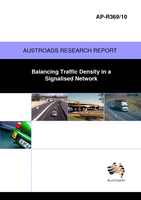Network

- Publication no: AP-R369-10
- ISBN: 978-1-921709-46-3
- Published: 25 October 2010
- PDF (free) Download
The current practice of balancing traffic density or distributing traffic evenly in a road network is essentially subjective and is achieved manually through expert opinions. This report summarises these expert opinions and investigates whether these practices can be implemented in a systematic manner with the use of an area traffic control system (ATCS) on surface streets. Both theory and practice confirm that a road network is a storage device in itself. It is reasonable to expect that arrival flows in excess of capacity are common occurrences in peak periods, and will be stored as vehicle queues. The aim of congestion management is therefore to (a) maximise exit flow and (b) ensure there is enough storage space for the excess queues. Current procedure and setup for an ATCS may not be conducive for effective congestion management in oversaturated conditions. Rather than aiming to only maintain a specific degree of saturation, signal timings can also maximise throughput or minimise/manage queue length.
Gating schemes based on an ATCS have been operational in Australia and overseas to resolve spill-over situations. Some general principles for its application are: identifying bottleneck links and gating links, choice of threshold values for gating to become active, distributing gating over several intersections, and employment of progressive gating with the gating intensity as a function of congestion. Future research is recommended in four areas: (a) making better use of detector data in SCATS and STREAMS or adding detectors at the upstream end of a road link to resolve the queue spill-over situation, (b) compiling a best practice ATCS guidebook, (c) trialling gating schemes at a corridor level and (d) incorporating platoon progression or offset feedback in an ATCS.
- 1. INTRODUCTION
- 2. THE SHIFT TO NETWORK OPERATIONS
- 2.1. The ‘Big Shift’
- 2.2. A Definition for Network Operations
- 3. THEORETICAL FRAMEWORKS FOR BALANCING TRAFFIC DENSITY
- 3.1. Principles of Network Equilibrium
- 3.2. ATCS and Network Equilibrium
- 3.3. Road Network as a Storage Device
- 3.4. Fundamental Diagrams for Arterial Roads
- 3.5. Other Recent Research
- 4. NETWORK OPERATION SCHEMES IN PRACTICE
- 4.1. Strategic Network Operation Schemes
- 4.1.1. Dutch Regional and Sustainable Traffic Management
- 4.1.2. VicRoads Network Operation Scheme
- 4.1.3. Main Roads WA Network Operations Strategy
- 4.2. US Approach to Signal Operation in Congested Conditions
- 4.3. Gating Schemes in Practice
- 4.3.1. Nottingham Traffic Collar Scheme in 1975-1976
- 4.3.2. Other UK Gating Experience Using SCOOT
- 4.3.3. Gating in City of Nijmegan in The Netherlands
- 4.3.4. Gating with SCATS in Melbourne
- 4.3.5. 2006 Commonwealth Games in Melbourne
- 4.4. Congested Traffic Operations in Other Jurisdictions
- 4.5. Summary
- 5. A CASE STUDY USING SCATS VR83
- 5.1. Data Analysis
- 5.2. Key Findings
- 6. CONCLUSIONS AND RECOMMENDATIONS
- REFERENCES
